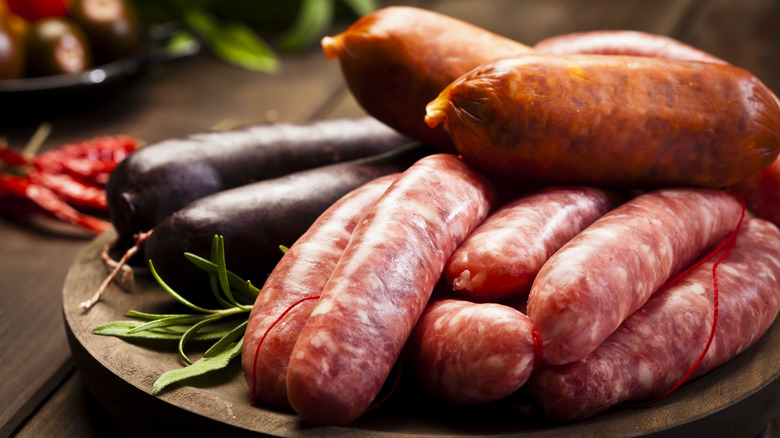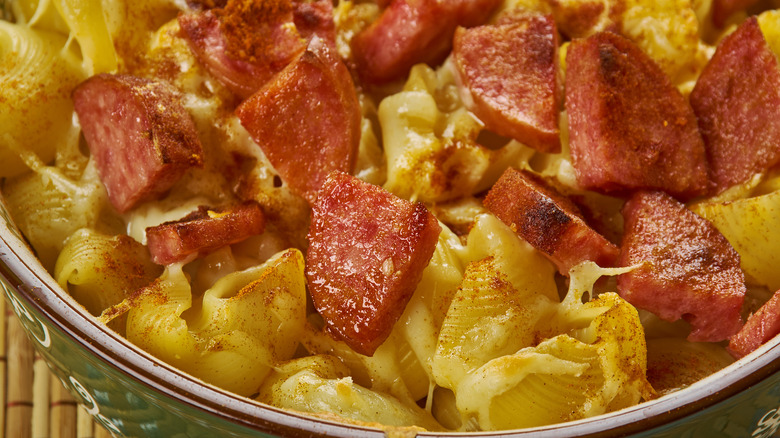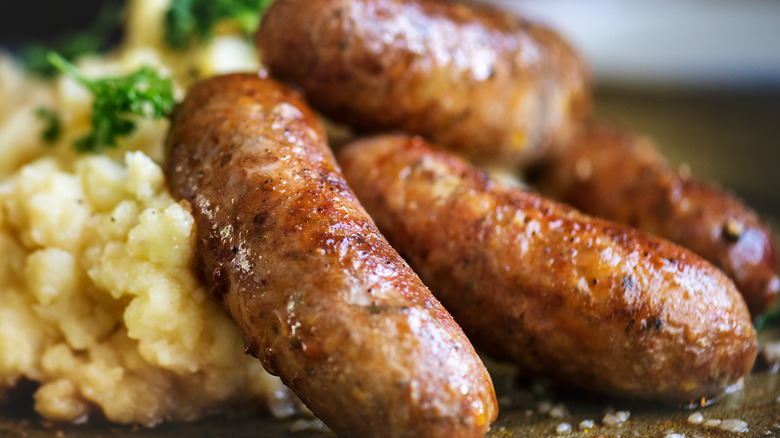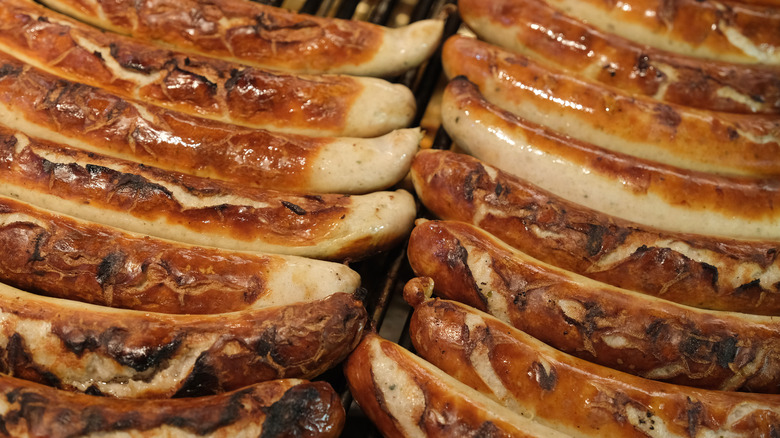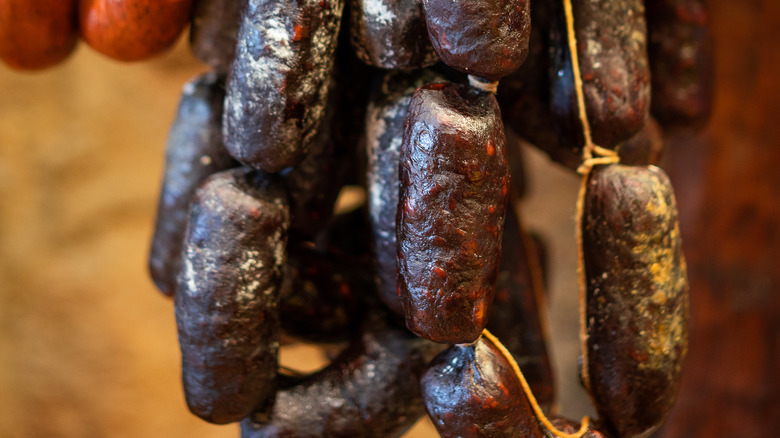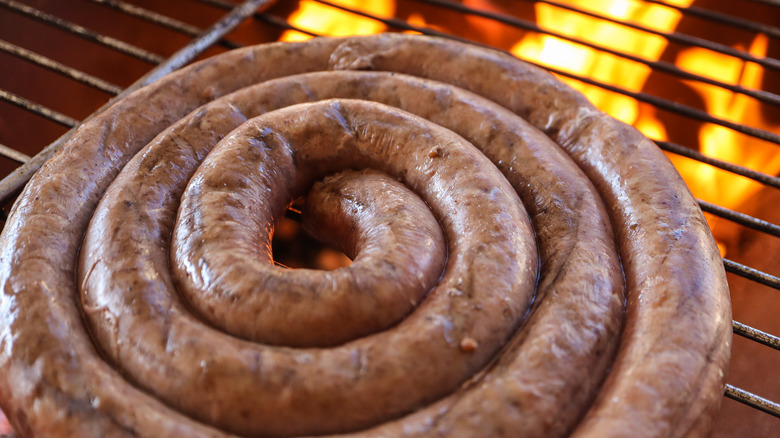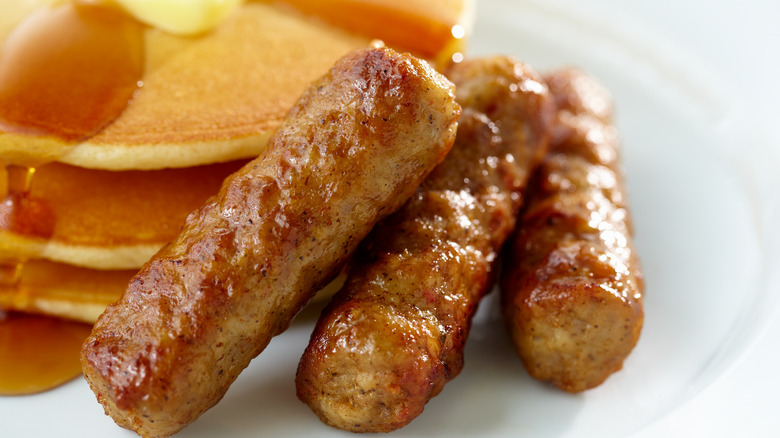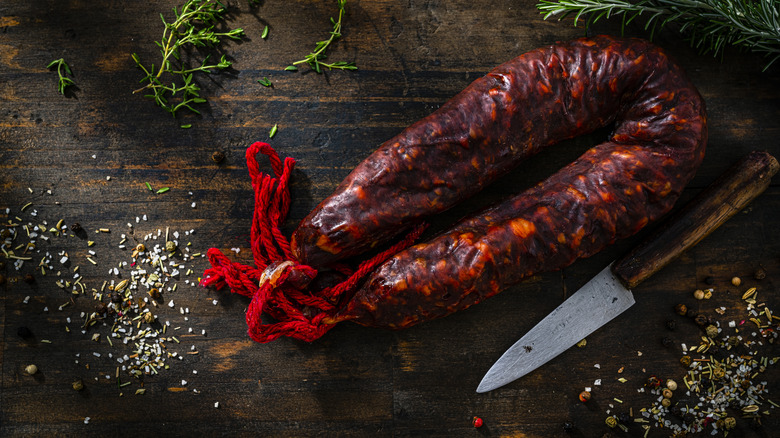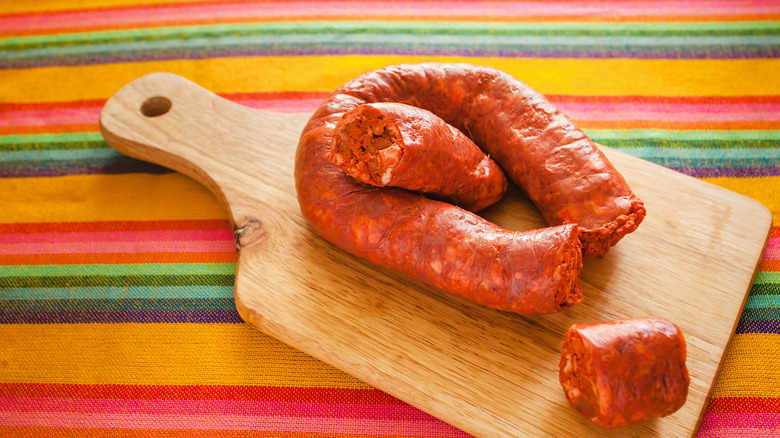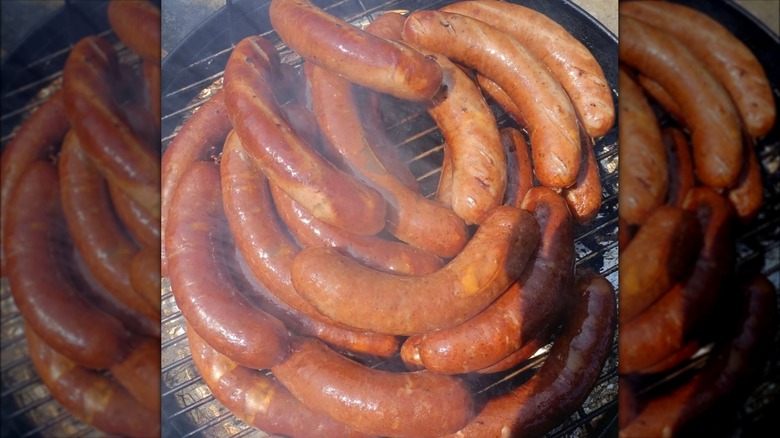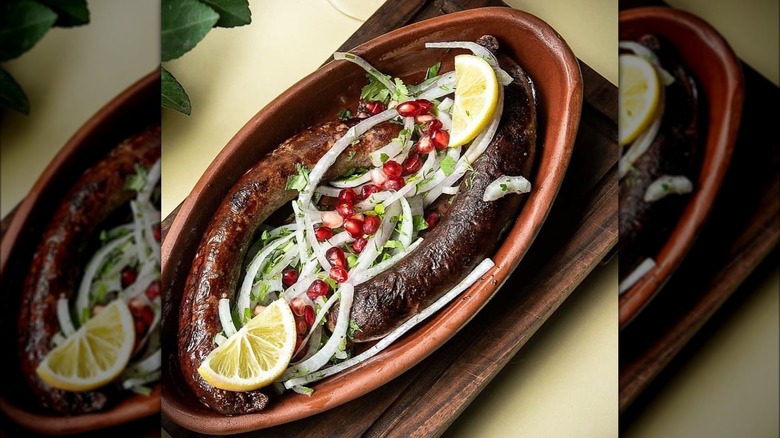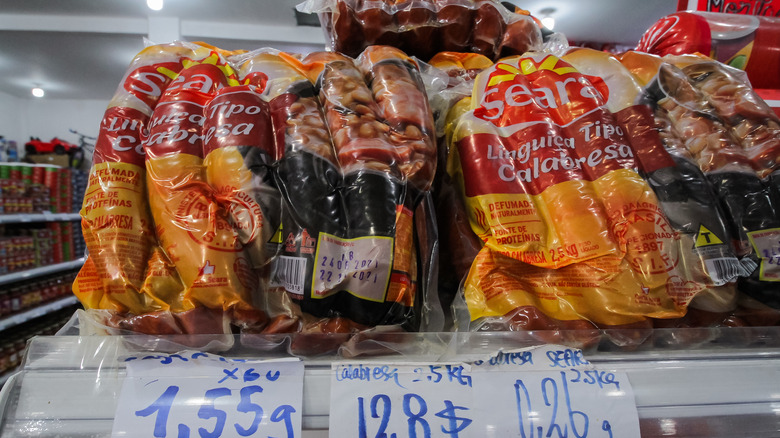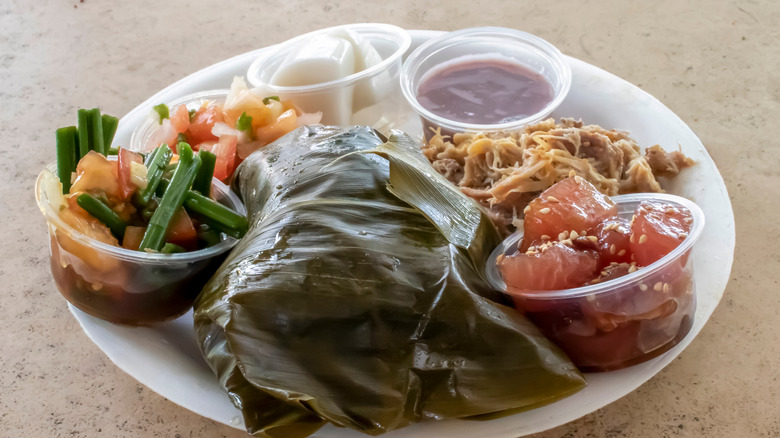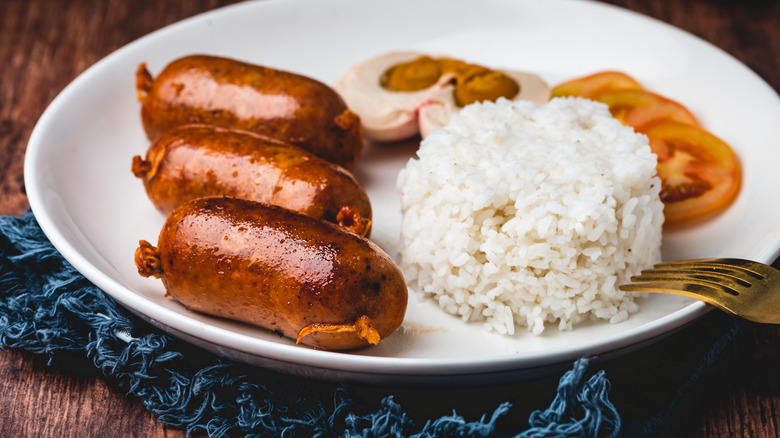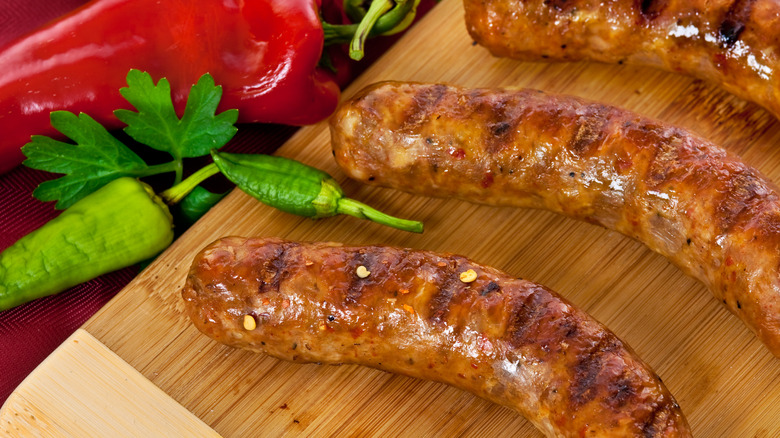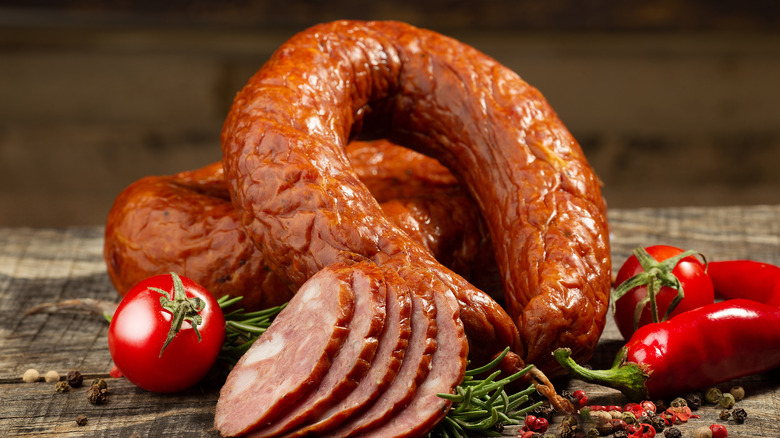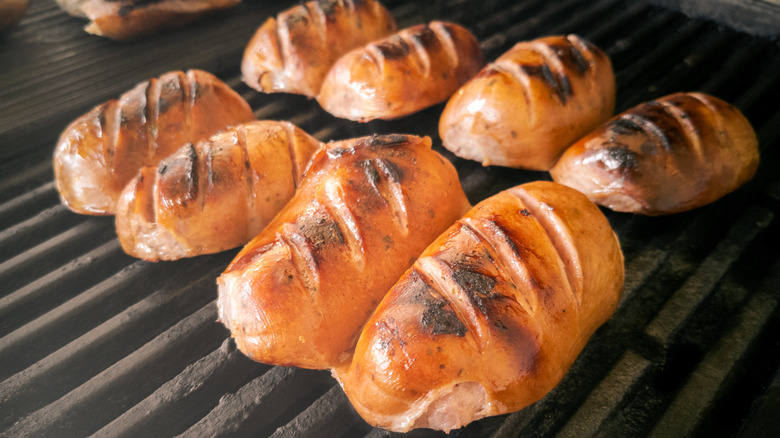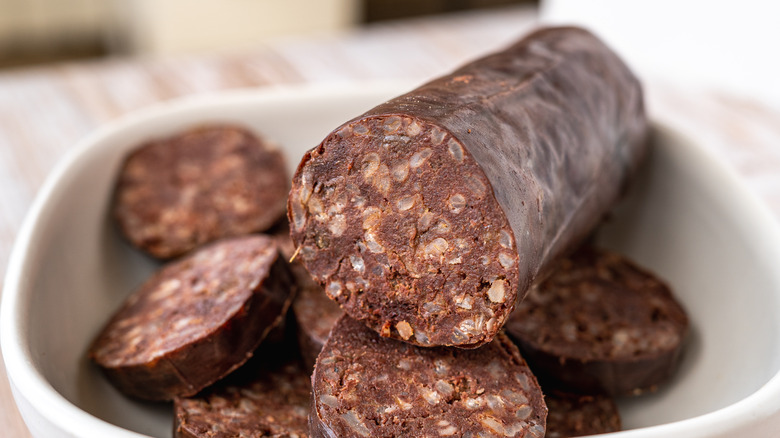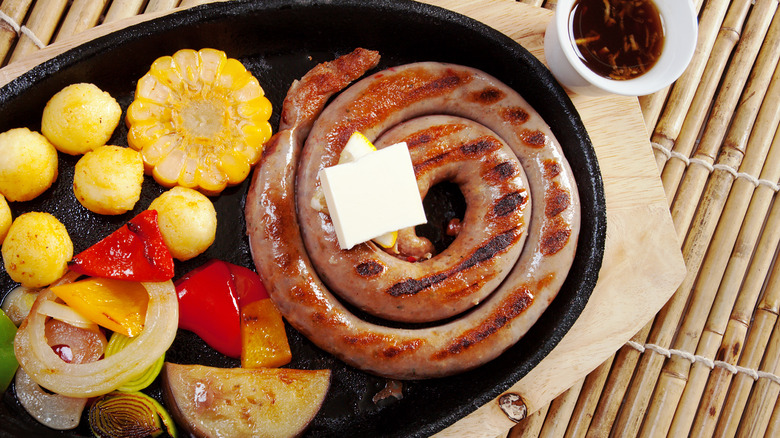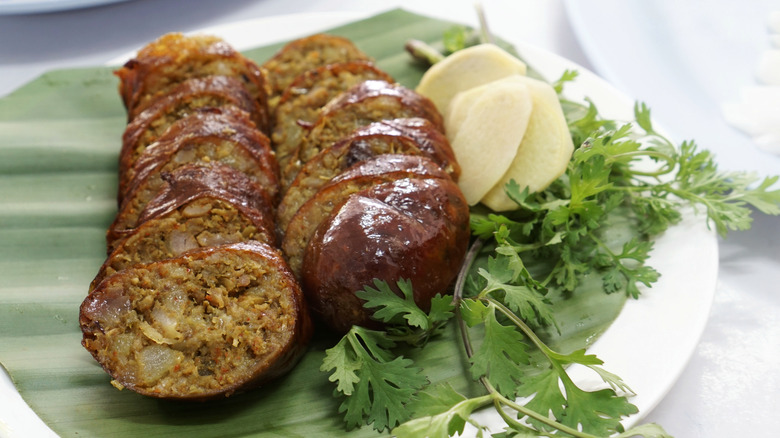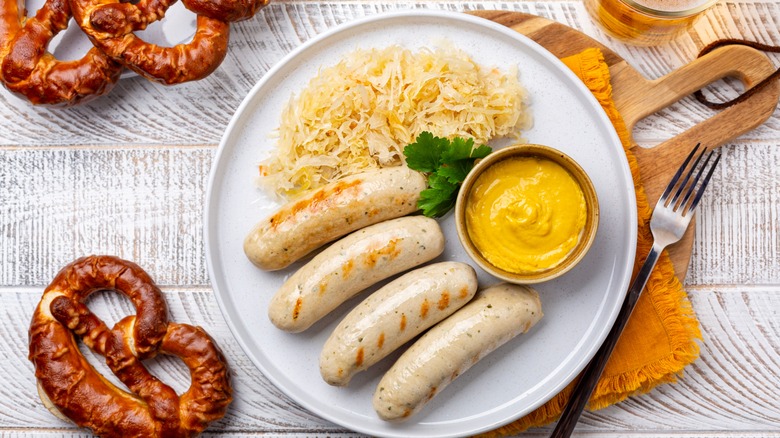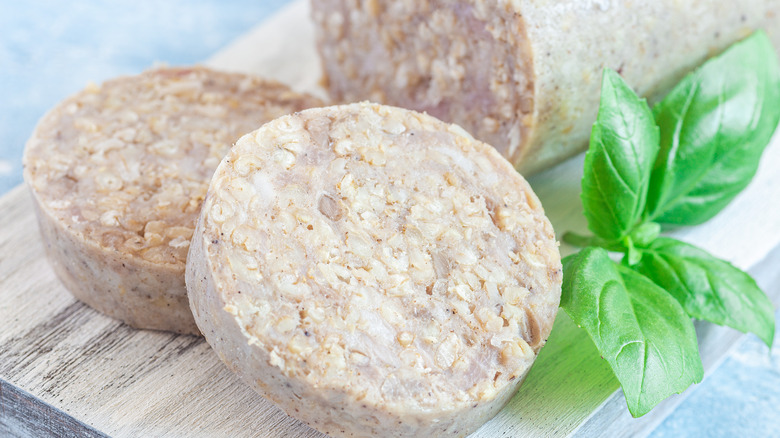24 Types Of Sausage, Explained
When you think of the word "sausage," do you think of the sad patty sitting on your lukewarm breakfast sandwich? Although this is how many folks, especially in America, think of the humble protein, the reality is that the food encompasses a wide range of flavors, meats, and seasonings worldwide. Almost every country has its own unique variety of this meat to satisfy almost any set of tastebuds.
The first sausages were believed to have originated in Mesopotamia several thousand years ago. The name is derived from the Latin word "salus," meaning "salted," which was the standard preservation method used for the meat. The sausage was particularly valuable for these early societies because it was a way to use up the less desirable parts of the animal, like the intestines for the casings and the organ means for the fillings. Since then, the sausage has been adapted to include other cuts of meat and flavors exclusive to different geographies. Here are some of the most popular types of sausages from around the globe.
Andouille
Andouille sausage is frequently associated with New Orleans Cajun and Creole cuisine, like gumbo and jambalaya, but this sausage's roots trace back to France. Southern Andouille is different than the French original because it uses pork shoulder and is spiced with Cajun ingredients like pepper, garlic, and cayenne. French Andouille varieties, such as the popular champagne Andouille, are made with the more flavorful pork tripe (often offal) seasoned with onions, herbs, and wine. The cooking methods between these two types of meat differ too; southern Andouille is smoked, while French Andouille is cooked in a skillet.
The significant differences between these two types of sausage mean that their uses are often segmented by geography and complementary ingredients. Southern Andouille is often paired with shrimp, rice, and beans, while French Andouille is often used for cassoulets, charcuterie, or serving with a tangy mustard sauce.
Bangers
Bangers are a British pork sausage often eaten with mashed potatoes, onion gravy, and peas in a dish appropriately named bangers and mash. The sausages themselves were given their unique name during WWI because of the sound of the water and the fillers in the sausage made when the meat was cooked.
The colloquial term "bangers" is really only used when referring to bangers and mash or English toad in the hole, a meal that encases a sausage in Yorkshire pudding batter. The sausages are often made with pork shoulder, fat, and seasonings like sage, mace, onion, and nutmeg.
Bratwurst
Bratwurst, or just "brats," are a staple food in Germany. Traditionally, these sausages were made with the leftovers of the animal and can come in beef, pork, or veal varieties. The meat is finely ground before being stuffed into a natural casing and cooked, which gives this sausage its mealy mouthfeel.
There are several different regional varieties of German bratwurst. The classic bratwurst, for example, is spiced with marjoram and made with a higher concentration of pork and beef fat. Würzburger bratwurst, which is found in the Bavarian region, combines the meat with local white wine to give it a distinct fruity flavor. Smoked bierwurst is seasoned with paprika, mustard seed, and peppercorns and is made through a tedious curing, smoking, and blanching process.
Black pudding
Black pudding is a British sausage made from combining grains and meat. The significant difference between white pudding and black pudding is that the darker variety is colored with beef or pork blood. This sausage combines blood, suet, and a grain (often oatmeal) with seasonings like onion in a casing before it is boiled, grilled, or fried. Black pudding is often served as an Irish breakfast component, or it can also be crumbled over mashed potatoes or served on top of soup.
Some blood sausages won't contain any additional cuts of meat besides the blood, while others incorporate ingredients like offal into the sausage. Outside Britain, you'll also see black pudding enjoyed in former British colonies like New Zealand and some parts of Canada.
Boerewors
Boerewors are a South African "farmer's sausage" made from beef, pork, and lamb. The exact composition of these sausages are highly regulated; it must contain beef, at least 90% meat, and more than 30% fat. The sausage is often seasoned with a myriad of regional spices, including coriander, black pepper, nutmeg, and malt vinegar.
The boerewors are often cooked in a large spiral on a braai (South African barbecue) and served alongside other South African staples like sosaties (smoky meat kebabs), braaibroodjies (a take on a grilled cheese sandwich), and a polenta-like dish called pap. You may also see the sausage served like an American hot dog on a bun with ketchup and mustard.
Breakfast sausage
Breakfast sausage is one of the most common types consumed in America. These bundles of protein can come in links (with or without casings) and patties. Fresh country sausage is the technical name for this pork product, which is most often seasoned with sage and pepper or more complex flavors like maple syrup or cayenne pepper.
Breakfast sausage can be seasoned based on your palate. Some breakfast sausages include fennel seeds, garlic, and coriander. Other recipes might also use other types of meat, like in our recipe for an easy breakfast turkey sausage, which skimps on the saturated fat but not the flavor.
Spanish chorizo
The chorizo sausage is one of the most well-known varieties of sausage worldwide. The Spanish and Mexican chorizo preparations share the same name because the countries share a language. However, important variations distinguish these two pork sausages from one another. The Spanish chorizo is centered around using paprika and additional aromatics like garlic, herbs, and wine. This sausage is fermented, smoked, and air-cured for at least three months, which means it can be eaten without any additional cooking. Some variations of the Spanish chorizo, including soft chorizo and Spanish chorizo semicurado, require additional cooking before eating.
Spanish chorizo has a texture akin to salami, thus making it a good fit for charcuterie boards or tapas (small plates). It can also be used on sandwiches, soups, or pasta.
Mexican chorizo
Like Spanish chorizo, Mexican chorizo is made from pork — although Trader Joe's makes a mean vegan alternative with textured vegetable protein. The main difference between these two sausages is the seasoning. Mexican chorizo is seasoned with regional ingredients like chili peppers, vinegar, and garlic. Although the chorizo links may undergo fermentation, they are most often left raw, thus requiring cooking before eating. This typically involves removing the meat from its casing and cooking it like ground beef.
Mexican chorizo can be used for a whole host of dishes including on breakfast foods like eggs, added to beans, or served inside of a taco. The pronounced spicy flavor and higher fat content give this sausage variety a unique taste that complements other ingredients and flavors.
Käsekrainer
The Käsekrainer combines the flavor of sausage with bits of heavenly cheese. It's an important facet of Viennese cuisine and is often served on a bun with ketchup and mustard. Moreover, the Käsekrainer makes an appearance on football match days across Austria. The primary components of the popular street food include a pork base (or occasionally, a mixture of beef and pork) and Emmenthaler cheese. The sausage is also often applewood smoked, which gives it a strong fireside flavor and crispy crust.
This sausage is a relatively new culinary invention. It was initially created in 1971 by Franz Thalhammer as a hybrid variety of the Carinolan sausage — a Slovenian beef and pork sausage — combined with Swiss cheese, garlic, onions, and spices.
Kupati
Kupati is a type of sausage from the Georgian region. It can be made from pork or beef, and traditional preparations utilize organ meats, including heart, liver, and kidneys. The protein is mixed with onions, garlic, black pepper, cinnamon, barberry, and dried coriander and can be grilled or fried. This popular type of sausage may also contain filler ingredients like potatoes, cheese, and mushrooms.
In Georgia (or the surrounding Caucus mountains), you're likely to see this horseshoe-shaped sausage served with sauerkraut, pomegranate seeds, and coriander. The garnish's visual sharpness and bright, floral flavors contrast the sausage's herbaceous yet robust profile.
Linguiça
Linguiça is a cured and smoked Portuguese pork sausage seasoned with paprika, garlic, and peppercorns. It has a very aromatic quality, making it a common pairing for pasta, clam bakes, and on top of pizza. The Portuguese caldo verde soup contains potato, kale, and linguiça. You'll also see the meat in a franceshina sandwich, which features cured ham, linguiça, and steak covered in a special sauce, cheese, and often an egg.
Linguiça is made from pork butt, the cut of meat from above the pig's shoulder. Occasionally, the meat is brined in salt and vinegar before being cased to add an acidic element to the meat. Many folks liken the flavor of the meat to a pepperoni, with a slightly spicier and garlicky kick to it.
Laulau
It may not be what you think of when you hear "sausage," but this protein-dense combination of fatty pork and salted fish wrapped up together in taro leaves technically counts as one. After the packet is made, it is steamed in a hot, underground imu made with banana leaves and a sandpit. Conventional preparations of the dish may, however, use appliances like pressure cookers and steamers to expedite this process.
The traditional laulau is often made with pork, but some variations on the traditional recipe use turkey, chicken, or corned beef. It's distinguishing factor is the use of taro leaves. These leaves are closely intertwined with Hawaiian culture, where it is a common belief that the leaves can ward off negative spirits and provide protection for all who eat them.
Lap Cheong
It's easy to confuse lap cheong and pepperoni at first glance. This Chinese sausage has the same color and texture as pepperoni but has a very extraordinary flavor thanks to the addition of MSG and baijiu (rice brandy). Lap cheong is prepared with lean pork, such as from the loin, neck, or belly, with supplemental fat. It is dried for a minimum of 12 days before being cooked. The sausage can be eaten hot or cold but must be cooked in a wok.
Lap cheong is popular everywhere in the county during Chinese New Year. "Lap" refers to the winter sacrifice and the last month of the Chinese New Year. You'll also see the dish eaten in other border countries like Taiwan, where the sausage is soft and sweet, and Vietnam, where the meat mixture may also contain chicken.
Longganisa
If you visit the Philippines, you have to try longganisa. These sausages are derived from the Spanish "longaniza," which was introduced to the area when it was under Spanish control. The food was introduced into the culinary vernacular and remained an "altanghap" food — one that can be eaten all day. However, the most popular time to eat these sausages is in the morning for breakfast, often served with garlic fried rice and a fried egg. The sausage is often accompanied by a vinegar sauce for dipping or pickled vegetables or fruits called "atchara."
There are two primary variations in longganisa: de recado (savory) and hamonado (sweet). Both of these flavor trajectories typically include a hefty amount of minced garlic. Different geographies will also have their regional flavors, such as Calumpit longganisa, which has a novel element of brown sugar and paprika, and Imus longganisa, which is made with soy sauce, vinegar, black pepper, and anatto for a myriad of sweet and savory flavor.
Salsiccia
We couldn't talk about sausages without mentioning the all-important Italian sausage (salsiccia). This versatile sausage appears in many different applications, including lasagnas, pasta, and on the grill. Most Italian sausage is made with pork and occasionally features added pancetta or pork neck.
The seasoning and accompaniments for this meat are dependent on the geographical region of Italy you're in. For example, Northern Italians often add pepper, cinnamon, white wine, and garlic to their sausages, while Southern Italians may add sun-dried tomato, fennel, and chili peppers. Some notable variations of the Italian sausage include Lombardy's luganiga, which is stewed and eaten with cabbage or spinach. In Naples or Tuscany, you'll find salsiccia grilled and prepared with turnip greens or served in a red sauce with polenta.
Kielbasa
Kielbasa is one of the most underrated sausages. This Polish sausage has many variations in preparation, but most U.S. consumers know it as "Polska kielbasa wedzona" — a massive, smoked pork sausage seasoned with garlic, pepper, and marjoram. This preparation does not require any additional cooking, although it is often cooked in a pan similar to a hot dog to develop a crackly crust. Other fresh kielbasas, such as the farmer's kielbasa, or Krakow-style, require additional cooking before the sausage can be eaten.
There's no right or wrong way to eat Kielbasa. If you travel to a Polish home, you'll likely see the meat eaten with ketchup and bread or served with dinner alongside starchy mashed potatoes and bread. The meat can also be grilled on a barbecue for a smokier flavor.
Knackwurst
Knackwurst might just be one of the most aesthetically-pleasing sausages you've ever seen. These short, German sausages are made with a medley of pork and veal seasoned with ample amounts of garlic. It has a much smoother and almost creamy texture compared to other German sausage varieties. The garlic also adds a unique punchy flavor to these sausages, making them more flavorful than a traditional German brat.
You'll often see knackwurst (or "knockwurst," if you're in America) served with other German fare like pretzels and sauerkraut. The traditional German farmer's breakfast, Bauernfrüstuck, is made with cubed hashbrowns, slicked knackwurst, peppers, and onions. The knackwurst can be boiled, grilled, fried, or baked — making for a very versatile meat at any time of day.
Morcilla
Spain's morcilla sausage is unique because it's made with pork blood. Similar to black pudding, this Spanish sausage is made with ground pork, seasoning, onions, and often rice. The inclusion of blood in this meat gives it a distinctive purple hue. Besides these staple ingredients, different areas of Spain will spice it up with special seasonings. For example, in Andalusia, the sausage is filled with aromatic spices like cinnamon and cloves. In Burgos, the sausage is made meatless (besides the blood and the lard) and seasoned with a locally grown Horcal onion.
Morcilla is often simmered in water before being cured, but some preparations like the one in Seville, eat the sausage raw. Once prepared, morcilla can be fried and served with bread and potatoes or stuffed into seafood.
Mutura
Mutura is the Kenyan blood sausage you should know about. This sausage is made with goat, cow, or lamb and is often served at celebratory events in the country. Many traditional sausage preparations utilize beef, tripe, and cow intestine seasoned with onions, red chili, garlic, salt, and pepper. Unlike blood sausages found elsewhere, the mutura has more aromatic components — like ginger, garlic, and chili — which give it a more intense flavor.
Initially, the mutura was only eaten by women as a form of appeasement because they were not allowed to participate in animal slaughter. But during Kenya's colonial period, the mingling of cultures caused the mutura to be adopted by other tribes and cultures. However, it eventually gained the stigma of being a poor person's food because it was often consumed in Kenya's slums.
Sai Ua
Sai ua, also called chiang mai, is a sausage found in Northern Thailand made with regionally-specific seasonings like lemongrass, galangal, garlic, and makrut (kaffir) lime leaf. Unlike European sausage varieties, these unique additions give the protein a floral flavor. The pork base of the sausage is seasoned with oyster sauce and soy sauce, which gives the meat a hint of saltiness and fishy flavor.
After the sausage is prepared, it is most often grilled and served in pandan leaves for breakfast or as a snack. Common accompaniments for sai ua include sticky rice, chili, nam prik, and ginger.
Sucuk
You know what they say: When in Turkey, try sucuk! Although that might not be a popular phrase, it does give you a reason to try this delicious beef (and sometimes lamb) sausage — which is one of Turkey's national dishes. Since Turkey has a large Muslim population, this sausage is not made with pork. Some geographical variations, such as in Kazakhstan and Kyrgyzstan, may use horse meat.
To prepare the sausage, the meat is seasoned amply with cumin, sumac, and other Turkish spices before being piped into natural or plastic casings. After curing for several weeks, the meat becomes more firm and flavorful. This sausage is often enjoyed pan-fried as a component of a traditional Turkish breakfast alongside cheeses, jam, toast, and olives.
Soondae
Soondae is a Korean blood sausage often served as street food. The sausage, which can also be spelled "sundae," is made from pork blood, glass noodles (often dangmyeon or vermicelli), and glutenous rice. The starchy additions make this sausage very chewy, and when paired with beef intestines, pork organs, or squid, it can be incredibly flavorful. It's often seasoned with ground-dried shrimp and aromatics like ginger, garlic, and peppercorns.
Some individuals have compared the texture of this sausage to a mochi, with a mildly fishy taste. It is often served with a spiced chili dipping powder or sauce but can also be found in some Korean soups.
Weisswurst
Weisswurst is yet another sausage hailing from Germany. The flavor is between a hot dog and a traditional German brat, with a firm, familiar texture. These sausages are traditionally made in the early morning, eaten within a few hours, and must be gently poached in the water to prevent overcooking. Unlike other types of German sausages, the weisswurst's casing is very tough to chew, so it's often eaten by sucking one end of the sausage or scraping the meat off the casing.
This sausage is best eaten with other German favorites, such as the Bavarian soft pretzel and a serving of spicy mustard.
White pudding
White pudding is essentially an oatmeal sausage found in Ireland, Scotland, and some parts of Canada. It does not contain any blood, like black pudding, instead deriving its flavor from a blend of suet, oatmeal or barley, breadcrumbs, white pepper, and coriander. The meat is prepared by boiling, cooling, and slicing it into coins or leaving it whole.
Each region has its variation on the white pudding. In Scotland, the white pudding isn't made with any meat and instead contains onions or leeks. The Canadians prefer oatmeal in their white pudding, while the Irish add pork meat and potato flour to make their white pudding a bit more sturdy.
